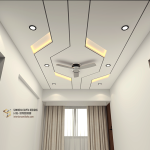When it comes to creating stylish yet functional ceilings, WPC false ceilings are a modern, sustainable, and versatile choice. As an interior designer with years of experience working with various ceiling materials, I’ve seen how well Wood-Plastic Composite (WPC) panels perform — both visually and practically — in residential interiors.
In this article, I’ll walk you through the key factors to consider when choosing WPC false ceilings for your home, along with a real project example to help you visualise the possibilities.
What is a WPC False Ceiling?
WPC (Wood-Plastic Composite) is a hybrid material made from a mix of wood fibres and plastic resins. It combines the natural look of wood with enhanced resistance to moisture, warping, and termites, making it an excellent material for false ceilings in Indian homes.
Key Factors to Consider When Installing WPC False Ceilings
1. ✅ Moisture Resistance
One of the main reasons homeowners prefer WPC panels is their high resistance to moisture and humidity. Unlike traditional wood or MDF, WPC doesn’t swell or degrade, making it ideal for ceilings in living rooms, balconies, bathrooms, or any space with temperature and humidity fluctuations.
2. ✅ Aesthetic Appeal & Finish Options
WPC comes in a variety of textures and finishes, ranging from light oak to deep walnut. Choose a finish that aligns with your home’s interior theme. Whether you prefer a contemporary, minimalist, or traditional look, WPC false ceilings add warmth and character to the room.
3. ✅ Material Combination for Visual Balance
WPC panels don’t have to cover the entire ceiling. In many designs — including one of our recent living room projects — we’ve used WPC panels strategically at the centre of the ceiling, bordered with gypsum for a clean, layered look.
This not only highlights the central chandelier but also creates a textured focal point without overwhelming the space.
4. ✅ Integration with Lighting
Plan your lighting layout in coordination with the WPC panels. Recessed lights, cove lighting, and even pendant fixtures work beautifully with WPC, especially when the panel layout frames or complements the light source.
In our project, the WPC ceiling frame enhanced the glow of the chandelier and added a layer of sophistication.
5. ✅ Ease of Maintenance
WPC ceilings require very little maintenance. They don’t need polishing or sealing like real wood — just an occasional wipe-down is enough to keep them looking fresh and new.
6. ✅ Eco-Friendliness
Made from recycled materials, WPC is a sustainable and environmentally responsible choice. If you’re trying to reduce your home’s carbon footprint, this is a smarter alternative to solid wood.
Pro Tip: Use WPC as a Highlight, Not the Whole Ceiling
Instead of installing WPC across the entire ceiling, consider using it selectively, like in the central portion of the ceiling or in bands. This helps maintain a light, open feeling in the space while still adding texture and design value.
Final Thoughts
A WPC false ceiling for home interiors is not just a trend — it’s a practical, long-lasting design decision. With its blend of aesthetic appeal, durability, and sustainability, WPC is an excellent alternative to traditional wood or gypsum.
If you’re planning a ceiling makeover, consider a hybrid design with gypsum borders and WPC accents to get the best of both worlds — timeless style and modern strength.
Need help designing your false ceiling?
Get in touch with us for personalised ceiling design consultations and turnkey interior design solutions in Pune and beyond.






